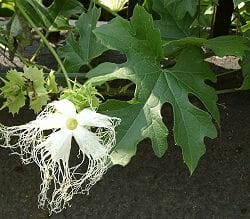 In this article, you will continue to explore the 50 fundamental Chinese herbs of traditional medicine, including a flowering plant that is now endangered in China, but a specimen exist right in the United States; and a rather helpful tea plant.
In this article, you will continue to explore the 50 fundamental Chinese herbs of traditional medicine, including a flowering plant that is now endangered in China, but a specimen exist right in the United States; and a rather helpful tea plant.
19) Dichroa febrifuga
This flowering plant belongs to the family Hydrageaceae, which is thought of as a rather important herb in traditional Chinese medicine.
20) Flueggea suffruticosa
This flowering plant belongs to the Euphorbiaceae family, which is also known as ‘ yÄ« yè qiÅ«’ in traditional Chinese medicine.
21) Saussurea costus
Belonging to the family Asteraceae, this plant is also referred to as ‘ yún mù xiÄÂng’ in traditional Chinese medicinal circles.
22) Trichosanthes kirilowii
This flowering plant is a member of the family Cucurbitaceae , also known as ‘guÄÂlóu’ in the world of traditional Chinese medicine. The plant also serves as a source for those looking for the chemical compound of trichosanthin. Trichosanthes is a genus of vines associated with tropical and subtropical climates. Throughout South Asia and Southeast Asia, the shoots, tendrils, and leaves of this species are sometimes eaten as greens and used in herbal remedies.
23) Psilopeganum
This genus of flowering plants belongs to the family Rutaceae and is known for originating from the Hubei province found in central China. Since its history in traditional Chinese medicine, the plant has become endangered. In the New York Botanical Garden, you may encounter a specimen. P. sinense is considered one of the 50 fundamental herbs of importance in the traditional ways of Chinese healing.
24) Stephania tetrandra
When taking a look at this species of flowering plant, you will learn a bit more about the family Menispermaceae. This herbaceous perennial vine can reach heights of 4 meters tall , possessing a woody appearance. The leaves decorate the stem in a spiral formation. Finding a place in traditional Chinese medicine, the plant is also known as ‘ han fang ji.’ If you are using as a natural remedy , please not that there are high levels of toxic aristolochic acid in the plant, which can cause the kidneys and renal system to fail. Some have also died from using too much of the plant.
25) Camellia sinensis
Teas are an important part of healing in the Chinese culture and this tea plant is a species that produces leaves and leaf buds that are made into a wide-ranging remedy. Belonging to the genus Camellia , you will find that white tea, green tea, black tea, and oolong are all harvested from this species. However, each is processed in a different manner to reach their full potential and varying levels of oxidation.
Camellia sinensis is native to Southeast Asia, but has found a place for cultivation all over the world in tropical and subtropical regions. The evergreen shrub or small tree possesses a strong taproot and becomes full of yellow-white flowers with 7 to 8 petals each. In medicine, the leaves have found a use in treating asthma, angina pectoris, coronary artery disease, and peripheral vascular disease. Studies are now looking at the tea extracts as a way to fight chronic bacterial infections.
